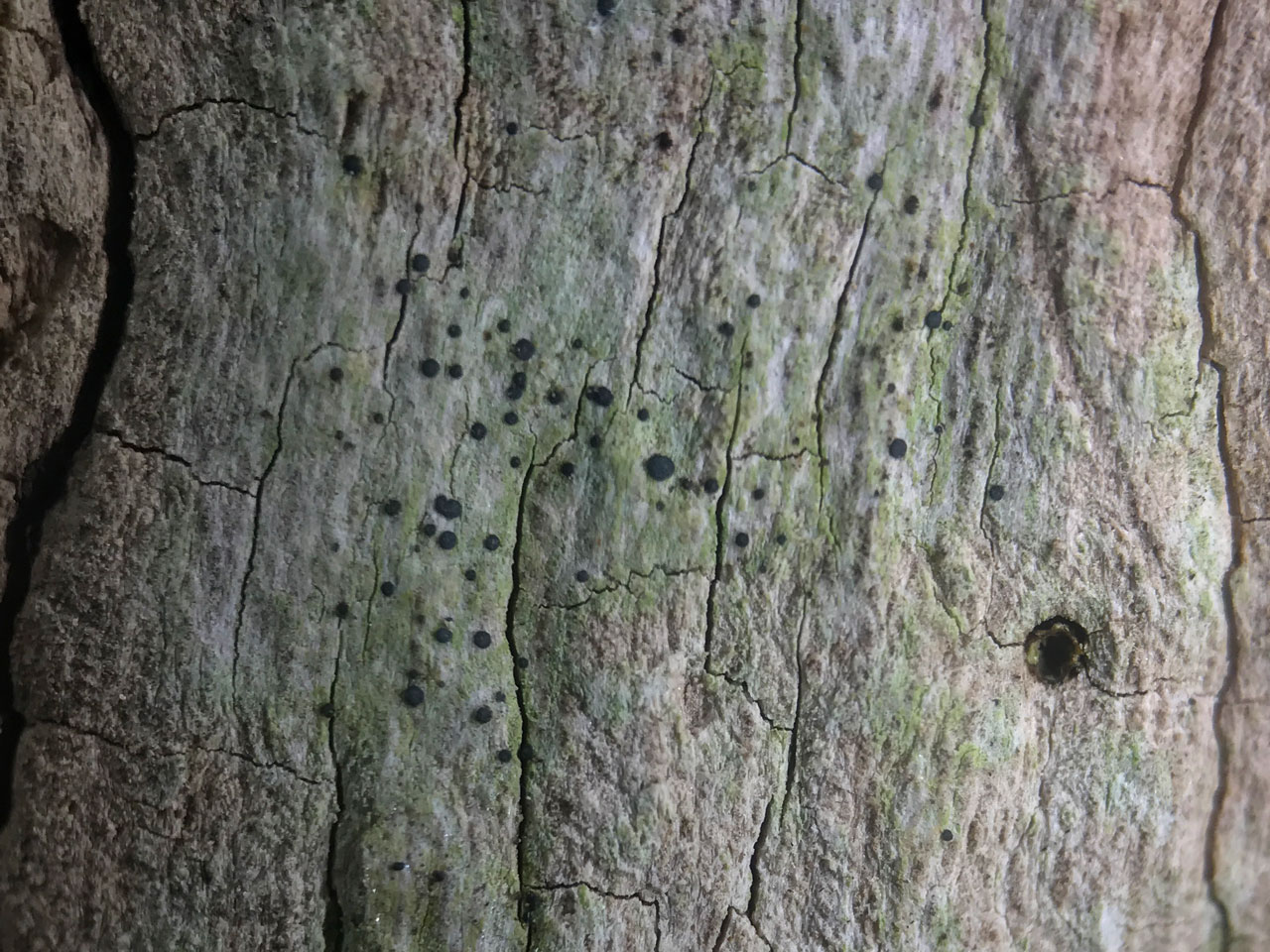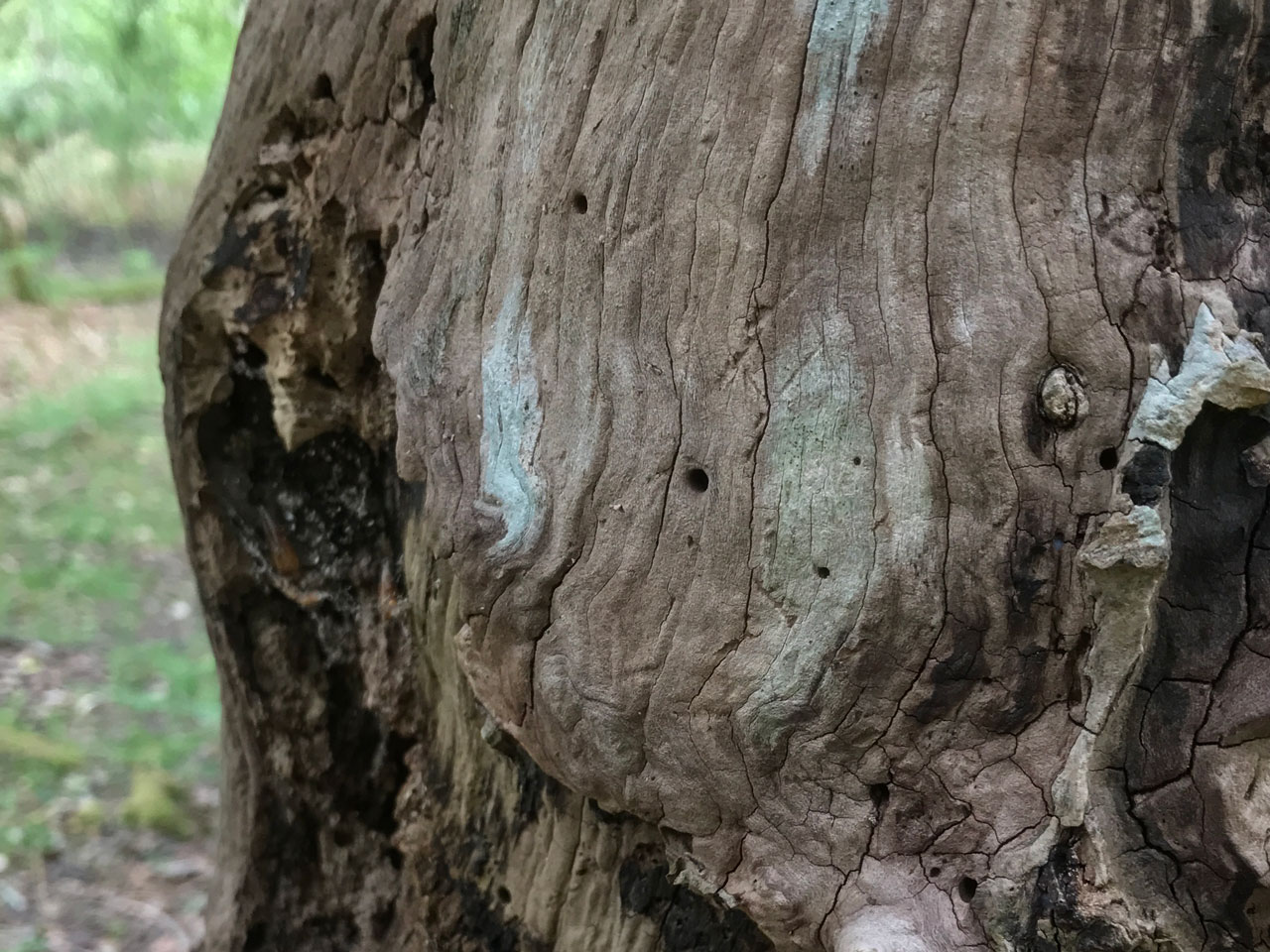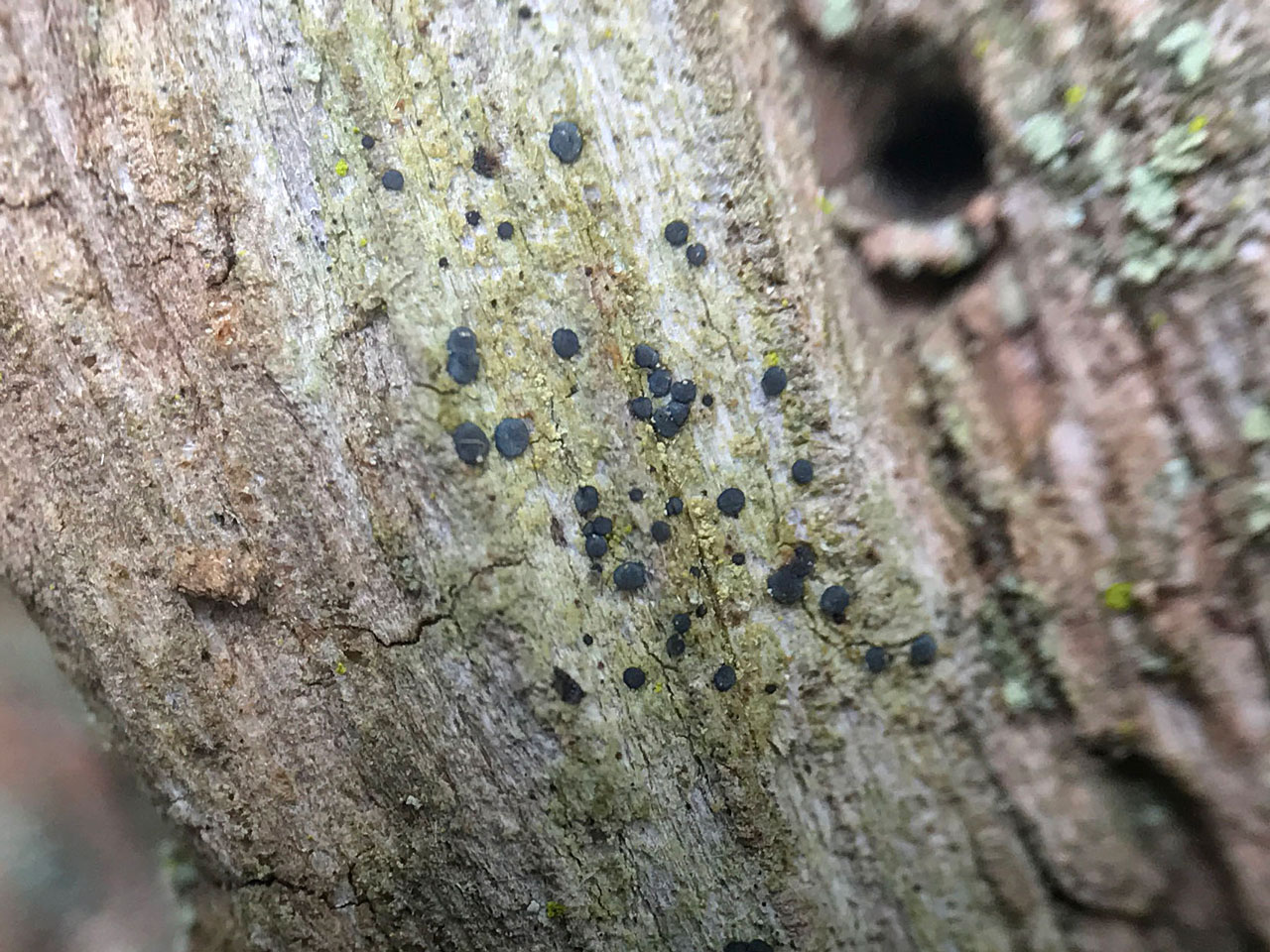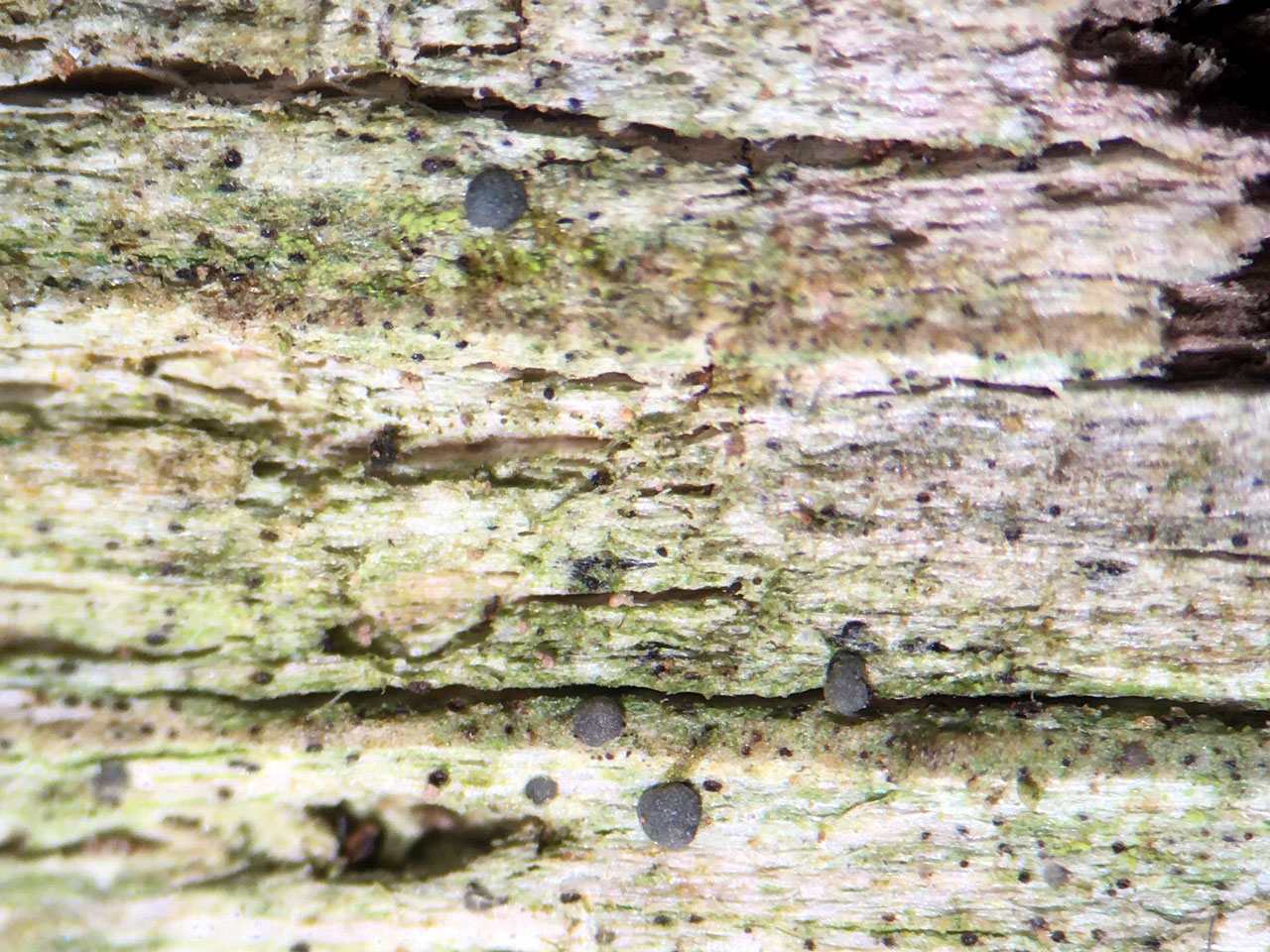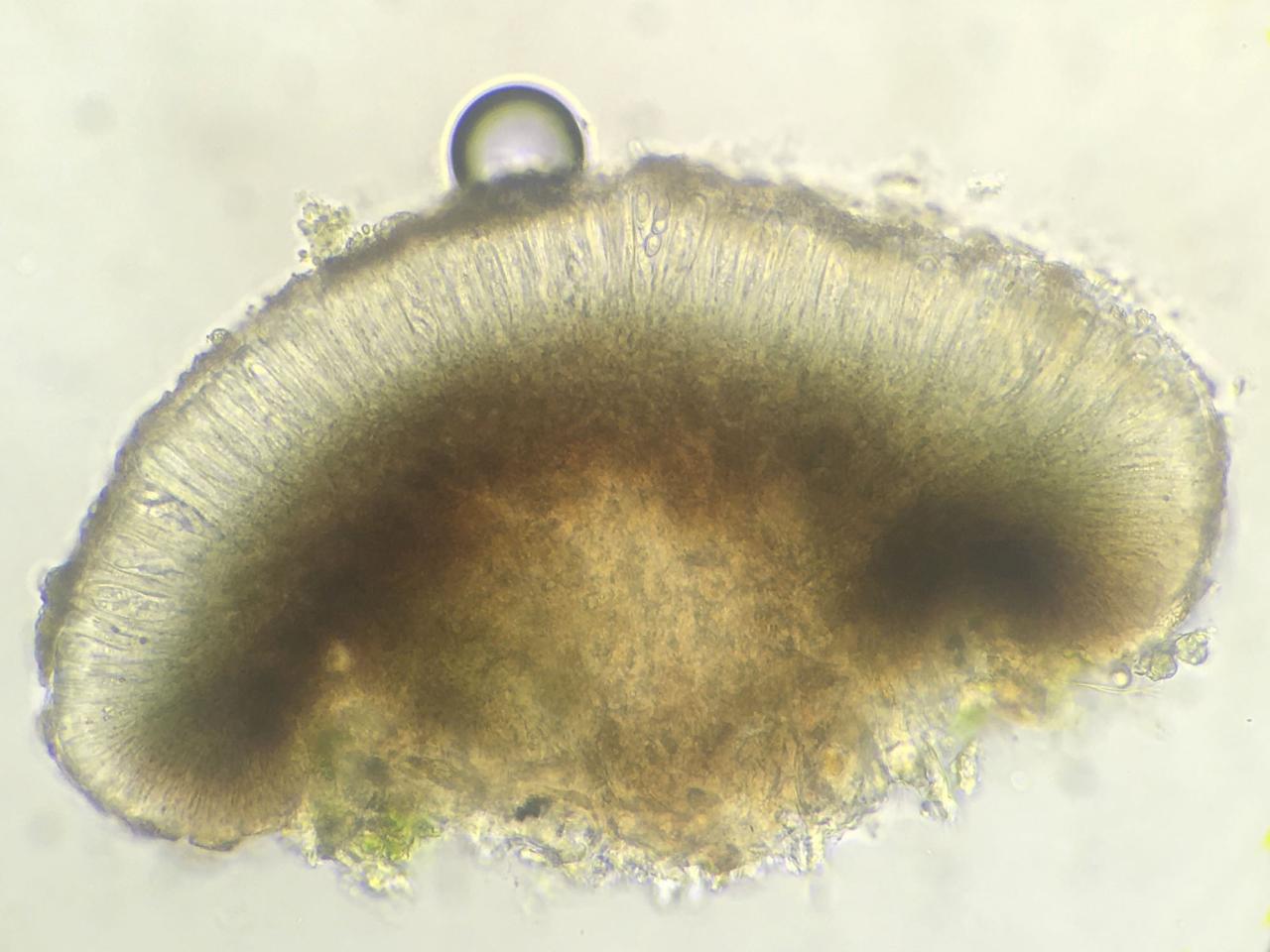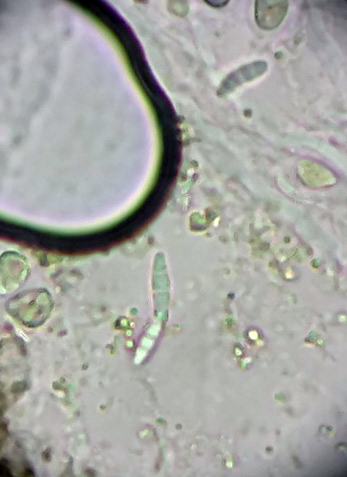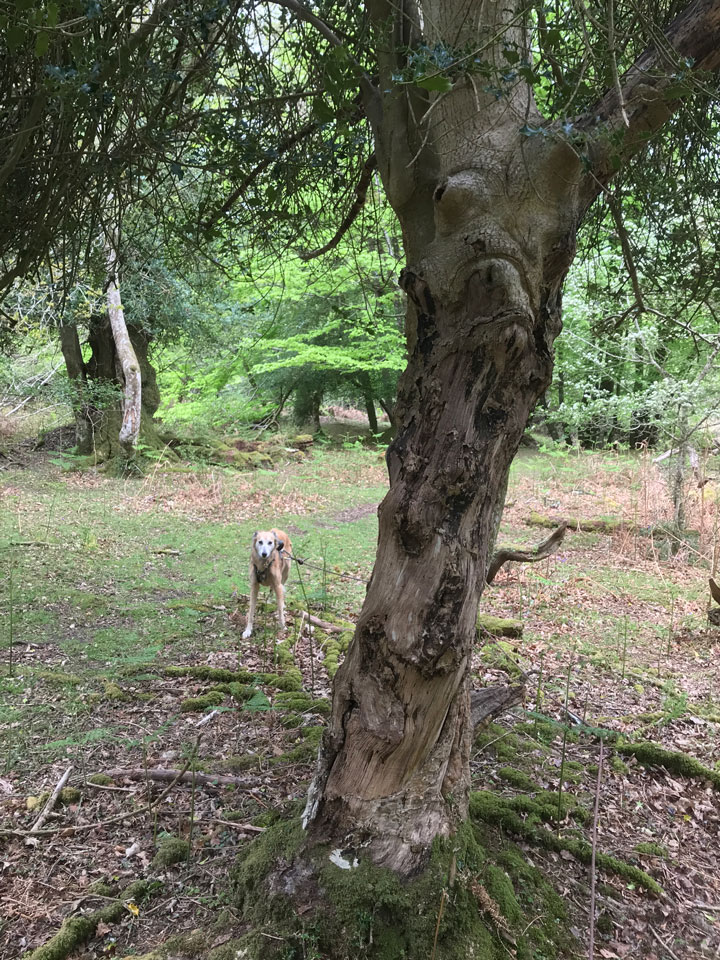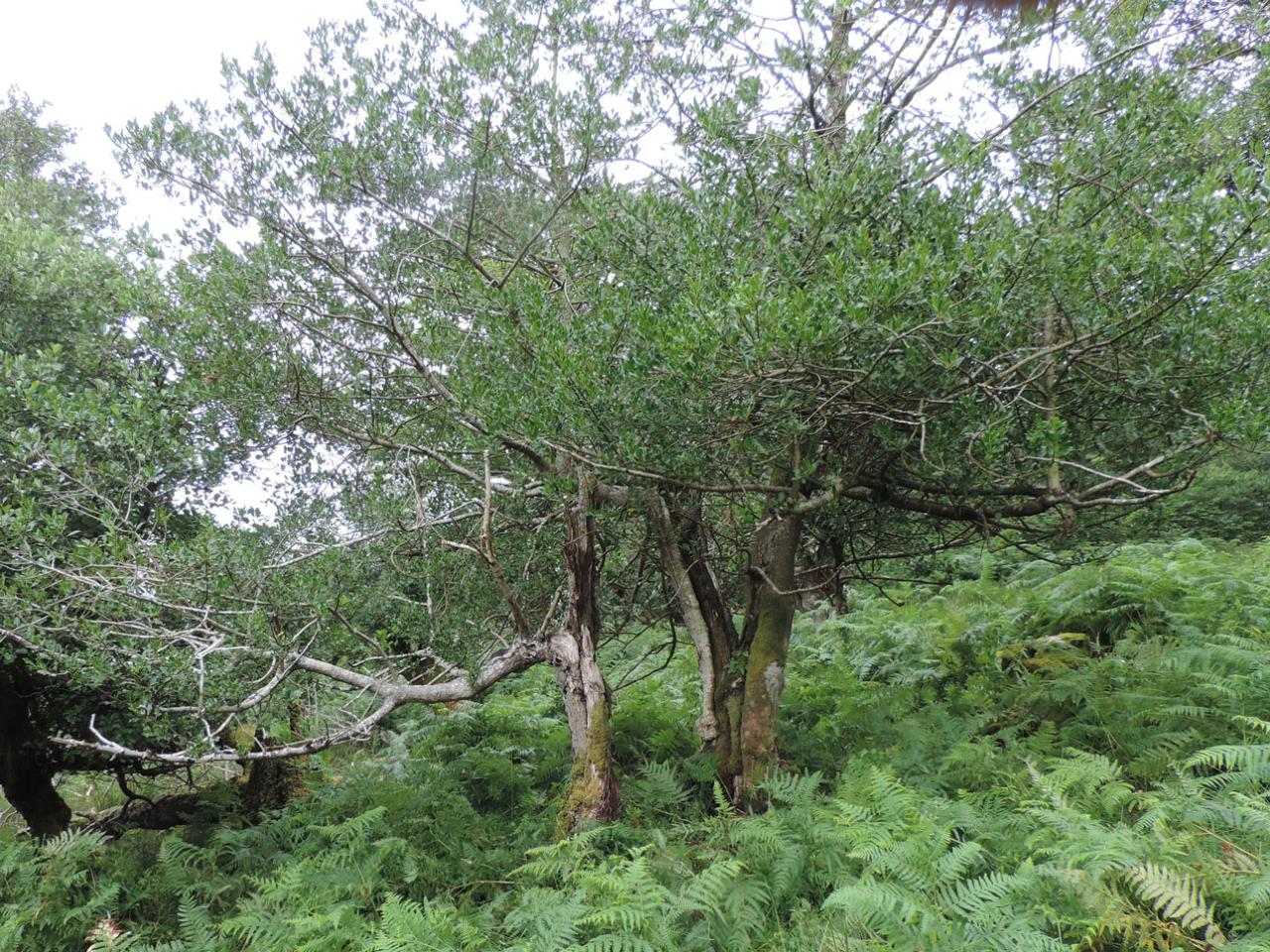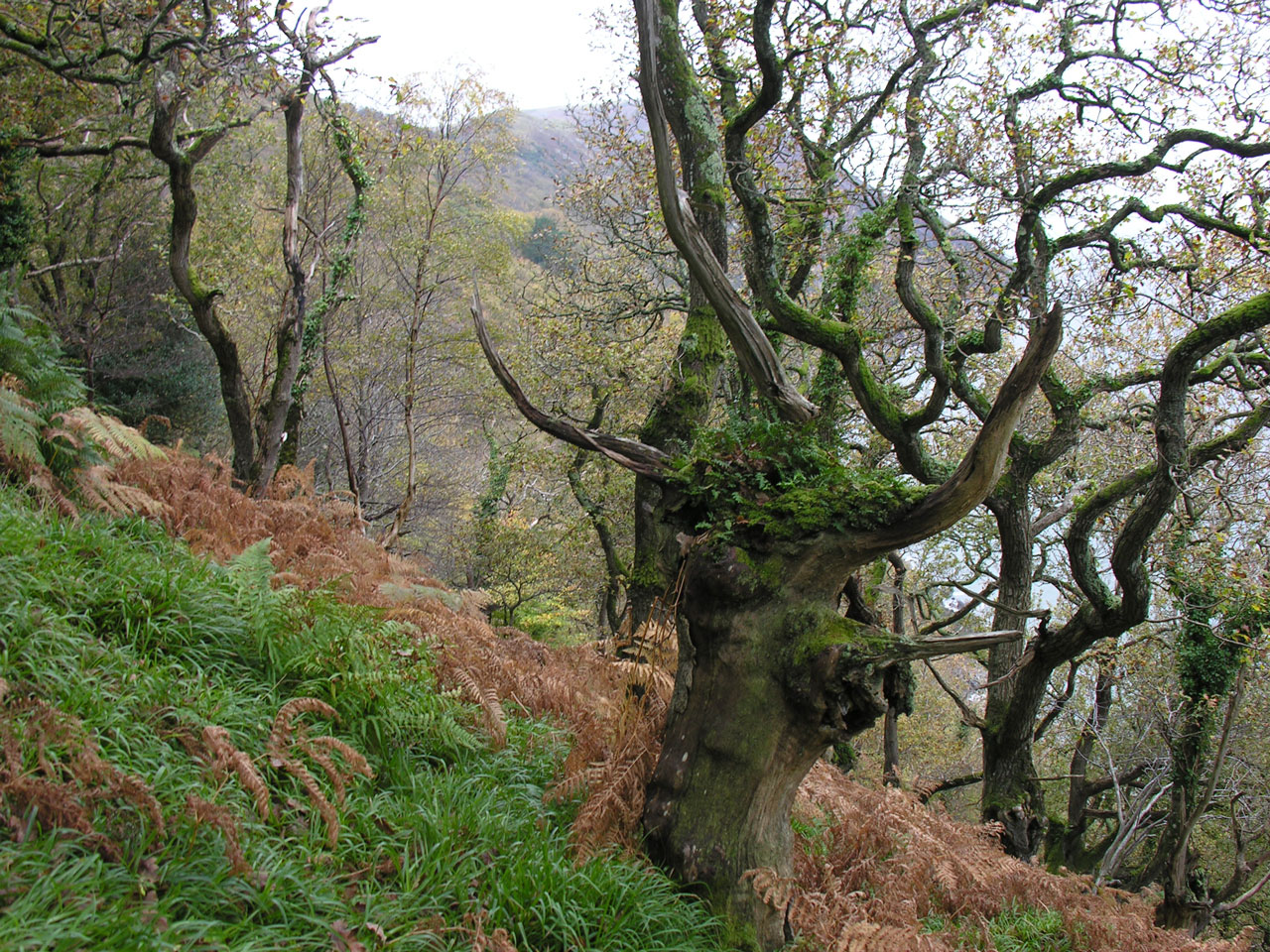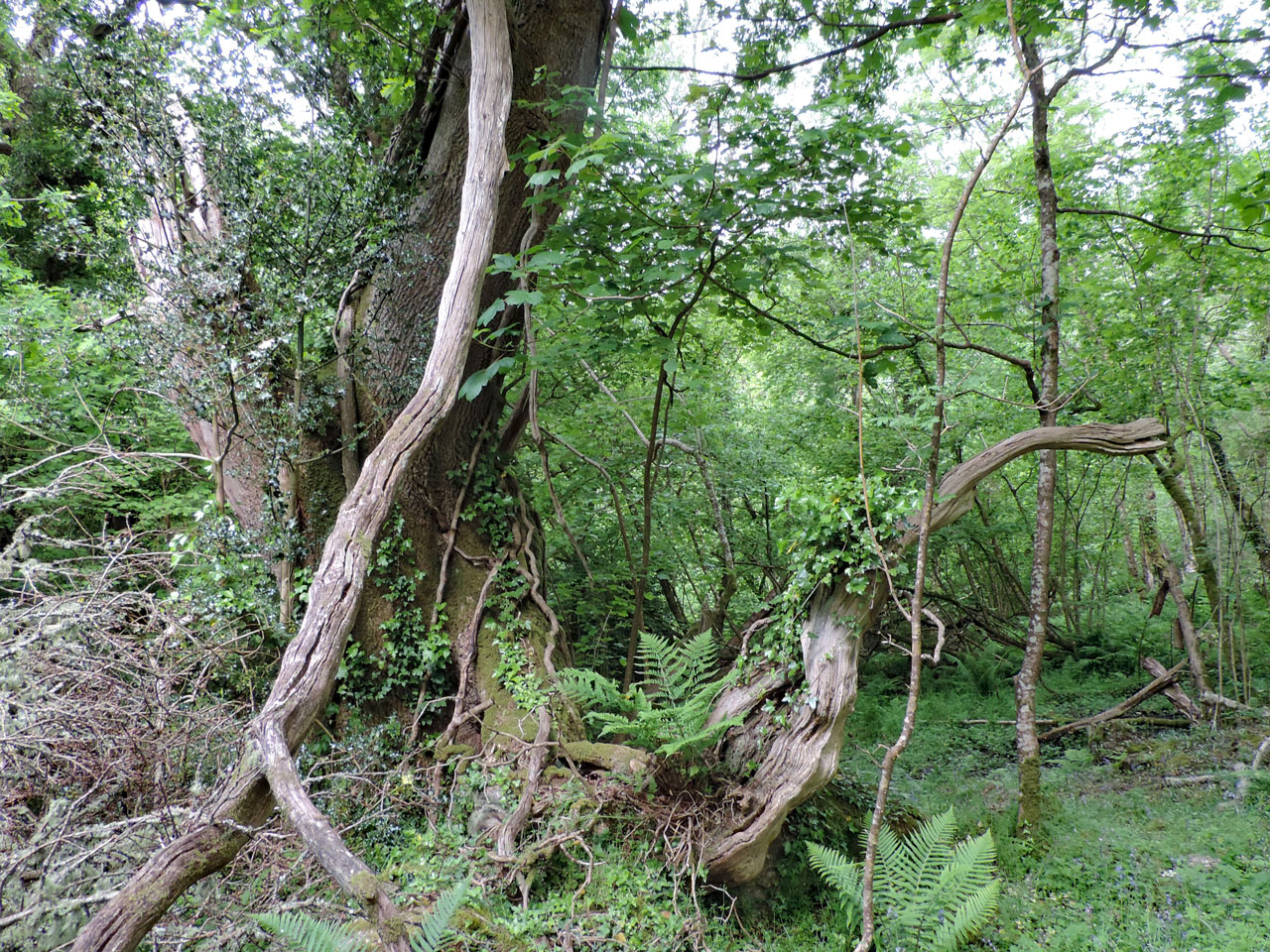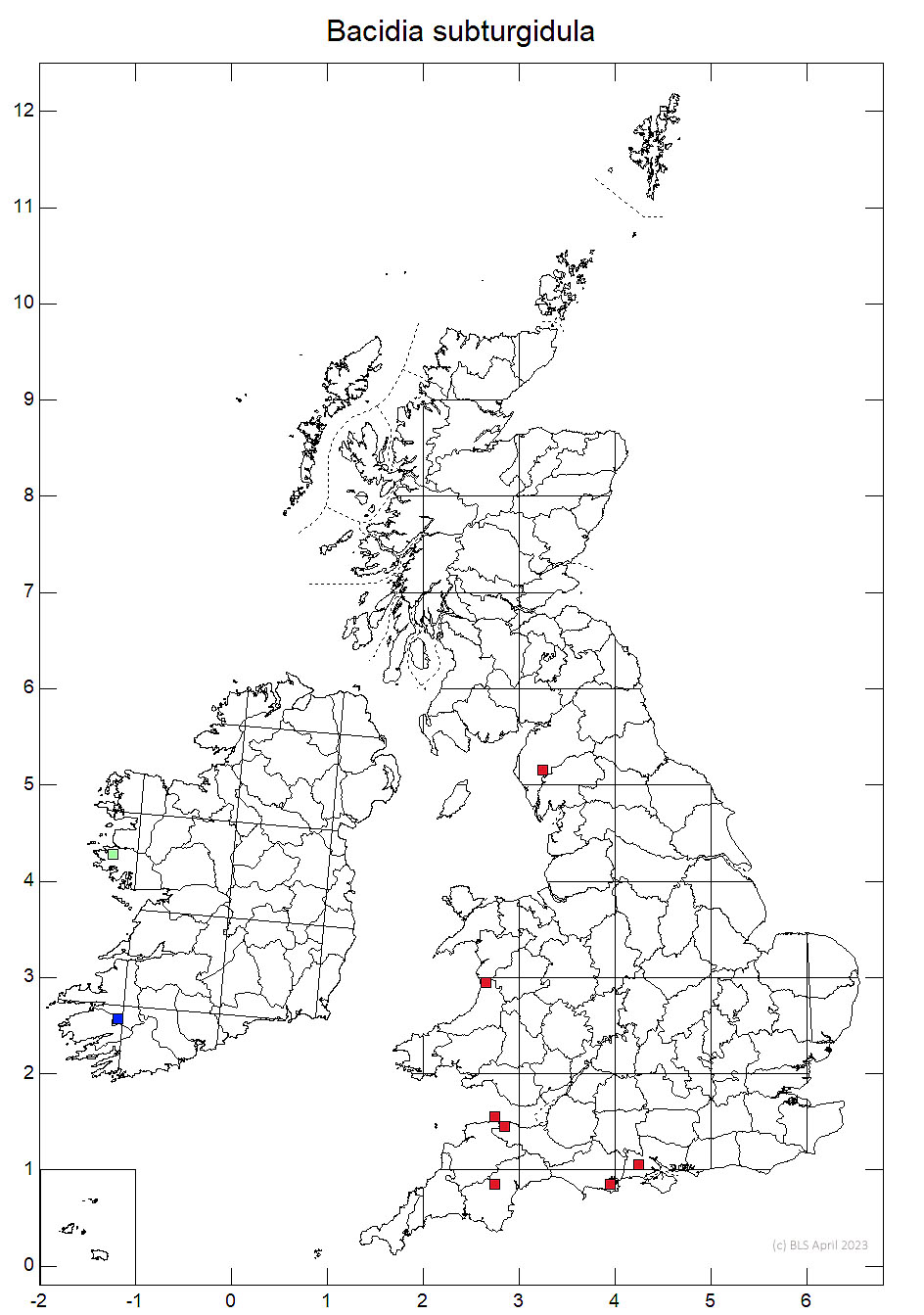Bacidia subturgidula
A very rare lichen, with pale blue grey apothecia with brown pycnidia, which is found on hard acid and weathered lignum on Holly and Oak in oceanic woodlands. Initially collected and described from Holly lignum in the New Forest between 1868 and 1873. One of the collectors, Charles du Bois Larbalestier, then found it in Co. Gallway in 1875, also on Holly. The lichen was not encountered again until in was collected in 1996 by Brian Coppins from Holly in Killarney, but not identified until many years latter. The New Forest population was rediscovered in 2003 on an old Holly by Neil Sanderson and Andy Cross. Since then it has been sparingly recorded from Devon to Dorset, in west Wales and in the Lake District. Rather similar externally to Lecidea turgidula, which also occurs on acid weathered lignum, but the apothecia are very different anatomically and it has larger black pycnidia.
Thallus immersed, green-grey to white; photobiont cells 6–12 (–14) μm diam. Apothecia 0.16–0.4 (–0.5) mm diam., flat to convex, bluish grey, grey-brown or brown-black, weakly to strongly blue-white pruinose, immarginate; true exciple inconspicuous, brown, K–, but pale and ± colourless at the outer edge, of radiating hyphae coherent in K, 1.5–4 μm diam. with lumina 1–1.5 μm diam.; hymenium 30–40 μm high, pale brown above due to minute granules that dissolve in K; hypothecium concolorous with the inner exciple; paraphyses 1–1.5 μm diam, unbranched or sparsely branched, ± slightly swollen at the apices. Asci Bacidia- or Biatora-type. Ascospores 9–13 × 2.5–4 μm, (1-) 3-septate, cylindrical to fusiform. Pycnidia 30–50 μm diam., numerous, immersed, brown, the wall red-brown, K–; conidia 9–11 × 1–1.5 μm, cylindrical.
In outward appearance the apothecia and pycnidia resemble those of “Lecidea” turgidula, which also occurs on Oak lignum within the range of Bacidia subturgidula, though the apothecia are very different anatomically and the pycnidia black and twice the diameter. The generic placement of both species requires investigation.
On lignum of old Holly (New Forest, Lake District & Ireland) and Oak (S.W. England, W. Wales). On Holly found on lignum both on the inside of hollow old pollards and on the trunks, where winter mammal browsing by fallow deer and ponies of the bark has exposed lignum. On Oak, found on both standing dead trees, on dead wood attached to live trees and once on a fallen dead Oak. The standing dead Oaks include both large diameter hulks and small diameter self thinned trees. Found on hard acid weathered lignum, often associated with Cresponea premnea on Holly. Generally in sheltered, reasonable well lit locations such as on the edges of glades in pasture woodlands.

Very rare, with recent records from S. (New Forest) and S.W. England (Devon & Somerset), W. Wales (Cardiganshire), Cumbria, S.W. Ireland (Killarney), but also with a 19th C record from Co Gallway, Ireland. Recently discovered in France (Gironde) link and possibly an western European endemic; reports from Bermuda (Berger & LaGreca 2014) from the lignum of dead Bermuda Cedar appear to be of a different species (very similar but the pycnidia are sessile rather than immersed and the conidia are one septate (rather than simple) and shorter 7–9 x 1–1.4 μm).
This potentially endemic species has very low populations in the sites it is known from and has been found from very few sites in two decades of search. It has, however, been found a somewhat more widely in southern oceanic woodlands since the last Red List assessment. It is both old growth dependant and intolerant of deep shade. Mainly threatened by increasing shade due to the decline in extensive grazing within woodlands. Records to 2003 are:
- SU20, New Forest, 4 Hollies, 2003 – 2021
- SY98, Arne, Dorest, 1 fallen dead Oak, 2016
- SX78, Bovey Valley, Devon, lignum on 2 live Oaks and 1 standing dead Oak, 2018
- SS75, Doctors Wood, Exmoor, on 1 standing dead Oak, 2009
- SS84, Hawk Combe, Exmoor, lignum on 1 live Oak, 2019
- SN69, Cwm Cletwr, Cardiganshire, 1 dead Oak, 2022
- NY21, Borrowdale, Cumberland, 1 Holly, 2018
Britain: Critically Endangered & an International Responsibility species
England: a Section 41 species
Berger, F. & LaGreca, S. Contributions to the lichen flora of Bermuda — Part I. New records, new combinations, and interesting collections of lichenized ascomycetes. Evansia 31: 41-68. https://doi.org/10.1639/079.031.0203 Link
Cannon, P., Ekman, S., Kistenich, S., LaGreca, S., Printzen, C., Timdal, E., Aptroot, A., Coppins, B., Fletcher, A., Sanderson, N. & Simkin, J. (2021). Lecanorales: Ramalinaceae, including the genera Bacidia, Bacidina, Bellicidia, Biatora, Bibbya, Bilimbia, Cliostomum, Kiliasia, Lecania, Megalaria, Mycobilimbia, Phyllopsora, Ramalina, Scutula, Thalloidima, Toninia, Toniniopsis and Tylothallia. Revisions of British and Irish Lichens 11: 1-82.
Text by Neil A. Sanderson based on Cannon et al (2021)
